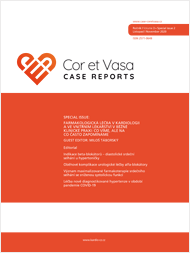 Cor et Vasa Case Reports
Cor et Vasa Case Reports
Ročník | Volume 3 • Číslo | Special issue 2
Listopad | November 2020

M. Táborský
Milé dámy, vážení pánové, vážení členové České kardiologické společnosti, u příležitosti letošních Českých kardiologických dnů jsme pro vás připravili speciální vydání Cor et Vasa Case Reports, které je věnováno kazuistikám z běžné klinické praxe. Dlouhodobě jsme informováni o výsledcích velkých klinických studií a jejich konsekvencích pro guidelines a léčbu našich pacientů. Řada kolegů má pak pocit, že...

J. Špinar, L. Špinarová
The article describes a case history of a 68-year-old woman. She was healthy till now, has got two sons and four grand-sons. All are healthy. Her husband has hypertension from the age of 60 and has problems with motion. He bought a digital tonometer and she has tried to measure her blood pressure. She was surprised, that her blood pressure was 160/100 mmHg, and therefore she asked me for a medical control. The patient underwent a 24-hour blood pressure monitoring which showed a clear hypertension and also echocardiography with a clear diastolic dysfunction. The lady confirmed that she has problems with breathing and natriuretic peptides confirmed diastolic heart failure. I have prescribed her betablocker (Betaloc® ZOK 25 mg) with a titration to 50 mg after 10 days and 100 mg after next 10 days and 200 mg after next 10 days. With the dose of 200 mg, the blood pressure normalised and she felt better, breathelessness was minimal, so we decided to continue with the monotherapy.

P. Janský
Urologic therapy with insufficiently selective alpha-blockers may be complicated by circulatory side effects, namely arterial hypotension and fluid retention. This tendency is markedly elevated in patients with cardiovascular disease. In this report two cases of serious circulatory complications in cardiac patients treated with alpha blocker tamsulosin for lower urinary tract symptoms in benign prostatic hyperplasia are presented. In both cases the disappearance of side effects and normalization of clinical status was achieved after withdrawal of tamsulosin and its substitution by substantially more uroselective alpha1A-blocker silodosin.

V. Danzig
Seventy-seven-year-old female with symptomatic dysfunction of left ventricle – ischemic etiology. The ejection fraction (EF) just after STEMI in 2014 was 40%, later variation of EF with minimum 35%. That’s why the ACE inhibitor was replaced by ARNI sacubitril/valsartan as an additive treatment to metoprolol in zero-order-kinetic form (and spironolacton) in dose of 200 mg once per day; this dosage is well tolerated by the patient. It is important to realize the maximization of pharmacotherapy even in relative stable patients in class NYHA II and always make the titration to maximum tolerated doses.

R. Kratochvílová
The current pandemic of COVID-19 has influenced many aspects of medical care in a negative way. The outpatient care was limited and the scheduling of medical checkups was very complicated during the declared status of emergency in the Czech Republic. There were also some uncertainties about the role of RAAS inhibitors in the pathogenesis of the coronavirus infection. That is why we preferred to start the treatment of a newly diagnosed arterial hypertension with a calcium blocker lercanidipine, which has proven long-term efficacy and a very low risk of side effects. To achieve an optimal control of blood pressure and minimize the symptoms of the patient we added a small dosage of a controlled-release beta-blocker metoprolol succinate to the combination with lercanidipine. This approach had favorable outcome.